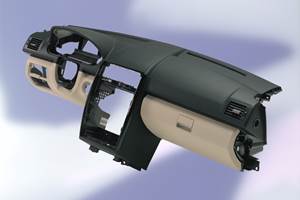No. 20 - Thermoplastic Elastomers
The invention of materials that process like thermoplastics but imitate the properties and feel of crosslinked rubbers began in 1958-59 with the commercial introduction of thermoplastic polyurethane and styrenic block copolymers (SBCs). The attraction of simpler and faster processing plus the ability to reprocess scrap gained these materials a permanent market niche that has expanded enormously since.
The invention of materials that process like thermoplastics but imitate the properties and feel of crosslinked rubbers began in 1958-59 with the commercial introduction of thermoplastic polyurethane and styrenic block copolymers (SBCs). The attraction of simpler and faster processing plus the ability to reprocess scrap gained these materials a permanent market niche that has expanded enormously since. At the same time, the families of TPEs have multiplied, though the most important categories are TPUs and SBCs plus the olefinics—TPOs, and TPVs—and copolyesters. Hard-soft overmolding with TPEs has become a widespread design trend for products from power tools to toothbrushes. A 2003 market study by the Freedonia Group in Cleveland forecasts 6.4% annual growth in world consumption of all TPEs through 2007 to a total approaching 5 billion lb.
Although pioneering work on TPU had been done as early as 1937 by Otto Bayer, it was C.S. Schollenberger of B.F. Goodrich Co. that first described it in 1958, and that company commercialized Estane TPU in 1959. (That ´óĎó´«Ă˝ is part of today’s Noveon.) Other early TPU suppliers included Bayer (Texin), Uniroyal (Roylar), Upjohn (Pellethane, later acquired by Dow), and Thiokol. Later key entrants include BASF (Elastollan) and Spain’s Merquinsa, which now sells its TPUs in the U.S.
From its early days, TPUs found a home in applications that require high abrasion resistance and low-temperature elasticity. One of the earliest applications was shoe heels, followed by seals, gears, and diaphragms. Film, sheet, and hoses are other major market segments.
Also in the late 1950s, Shell Chemical launched Kraton, the first commercial styrenic block copolymer (now made by a separate company called Kraton Polymers). Footwear was among its first applications of this SBS-type TPE. Later introduction of SEBS grades with improved chemical and uv resistance and better tensile properties opened up opportunities in industrial components and a wide variety of soft-touch consumer applications. Later market entrants included Phillips Petroleum (no longer in that field), Fina (now Atofina Petrochemicals), Repsol, and Japan’s Kuraray, which now makes products in the U.S. under the name Septon Polymers. In addition, a host of companies (including AlphaGary, Consolidated Polymer Technologies, GLS, J-Von, Kraiburg, Multibase, Polyone, RTP, A. Schulman, Star Thermoplastic Alloys, and Teknor Apex to name a few) compound and alloy SBCs to produce proprietary TPE compounds.
Enter the olefinics
Early olefinic TPEs included the first commercial thermoplastic vulcanizate (TPV), Uniroyal’s “TPR.” Launched in 1971, this partially-vulcanized TPV was made by dynamic crosslinking of EPDM with a peroxide in the presence of PP. Uniroyal was a pioneer in demonstrating that, while not possessing all the properties of vulcanized rubber, such a TPE had sufficient properties for many applications with the added advantage of easy molding of parts and remolding of scrap. It also sold at a very competitive price and could be molded, extruded, blow molded, and calendered using standard equipment for applications such as wire and cable, automotive parts requiring resistance to compression set, and soft tubing applications.
In 1981, the first fully-cured TPV was introduced by Monsanto under the name Santoprene. Monsanto was one of the companies in the Akron, Ohio, area that were looking for new tire-making technologies. It investigated several ways to make rubber mold more like plastics with the idea that plastic-like rubber would process faster and could be lower in cost. While the tire application did not work out, this new class of fully cured TPVs found thousands of applications as replacements for thermoset rubber. One of the first commercial uses was an automotive body plug. Monsanto formed Advanced Elastomer Systems (AES) to market Santoprene and additional TPV product lines (Geolast and Vyram). AES is now part of ExxonMobil Chemical.
Applications for TPVs (now also made by Basell, DSM, Nova, and Teknor Apex, among others) range from seals and gaskets to industrial tubing, automotive and building window seals, underhood components, and a myriad of hand-grip applications.
At around the same time Uniroyal was developing and launching its TPR, a host of competitive products began to appear, most of which were blends of unvulcanized EPM or EPDM elastomers with PP and/or PE. They came to be called thermoplastic olefins or TPOs. Originally made only by mechanical blending, they now can also be made in the reactor. Because of their relatively low cost and ability to be reprocessed together with other PP-based materials, TPOs and TPVs are taking over more and more automotive interior and exterior applications, displacing various other plastics.
Initial automotive TPO applications included sight shields, anterior grilles, knee guards, steering-wheel covers, and side pockets. Bumper fascias became one of the largest volume applications, largely displacing RIM urethanes. TPOs are currently invading new territory in instrument-panel covers, replacing vinyl and PUR foam laminates. Non-automotive TPO applications run the gamut from wire and cable to lawn/garden and agricultural equipment, recreational vehicles, toys, and sporting goods.
One of the first automotive-oriented TPO families came from RPI (Research Products Inc.), which later became Dexter Corp., D&S International, and then Solvay Engineered Products. In 1974, Hercules (now Basell) introduced Pro-fax SB-814, a high-hardness grade, and B.F. Goodrich launched Telcar TPOs (since acquired by Teknor Apex). These were followed in 1976 by DuPont’s Somel ethylene-propylene TPEs. Other TPO entrants have included DSM (Keltan), Equistar (Flexathene), Exxon (Vistaflex), International Synthetic Rubber (Uniprene, now from Teknor Apex), Japan Synthetic Rubber, Multibase (Multiflex), Mitsui (Milastomer), Montedison (Dutral), Ren Plastics (Ren-Flex), A. Schulman (Polytrope), and Washington Penn Plastics.
Engineering TPEs
Research on copolyester TPEs began at DuPont in 1950. In 1972, the company introduced its Hytrel family based on a crystalline PBT hard segment and an amorphous glycol soft segment. Although more expensive than TPUs, copolyesters boast up to 50% faster injection molding cycles and less stringent drying requirements. Akzo (now DSM) followed later with Arnitel copolyester, GE Plastics with Lomod (no longer available), and Ticona with Riteflex. Initial applications included flexible couplings, o-rings, seals, and gaskets, as well as oil-field parts and extruded hose. In 1985, Eastman entered the market with Ecdel, the first clear copolyester TPE, aimed at medical I.V. bags.
Today, the most active area of “engineering” TPEs extends the concept of a vulcanized rubber in a thermoplastic matrix. In the past two years, “super-TPVs” have emerged based on silicone or acrylate rubbers in nylon or polyester, as well as styrenic rubbers in PP. These products come from DuPont, Goodyear, Multibase, Teknor Apex, and Zeon Chemicals.
Related Content
Tracing the History of Polymeric Materials -- Part 30: Polyurethane
In the world of polymers, polyurethane chemistry is probably the most versatile. This a resulted in a wide range of products made from these materials and given the industry the flexibility to respond to the progressive march of regulatory concerns.
Read MoreCustom 3D Printed Parts Made From Bio-based Elastomers
Erpro's custom part printing service will now offer Arkema's Pebax RNew elastomer.
Read MoreTracing the History of Polymeric Materials -- Part 29: Polyurethane
This material family has unparalleled versatility, not only in terms of the forms the material can take, but in the different ways in which it can be processed.
Read MoreICIS Launches: Ask ICIS Generative AI Commodities Assistant
Said to be the first of its kind, this AI assistant will enhance access to ICIS’ intelligence and insights for the energy and chemical markets.
Read MoreRead Next
See Recyclers Close the Loop on Trade Show Production Scrap at NPE2024
A collaboration between show organizer PLASTICS, recycler CPR and size reduction experts WEIMA and Conair recovered and recycled all production scrap at NPE2024.
Read More








